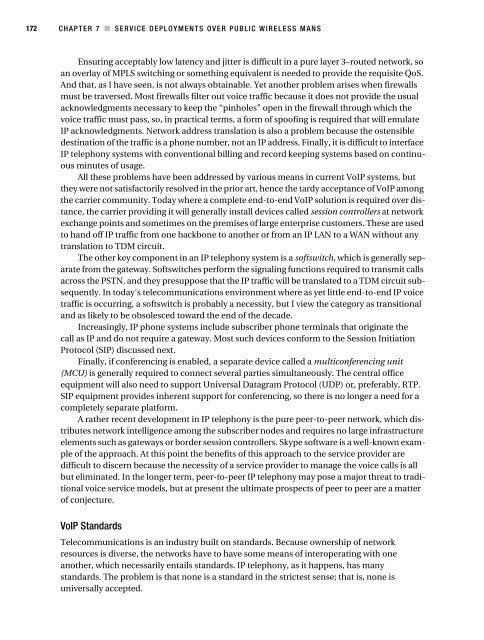WiMax Operator's Manual
WiMax Operator's Manual
WiMax Operator's Manual
Create successful ePaper yourself
Turn your PDF publications into a flip-book with our unique Google optimized e-Paper software.
172 CHAPTER 7 ■ SERVICE DEPLOYMENTS OVER PUBLIC WIRELESS MANS<br />
Ensuring acceptably low latency and jitter is difficult in a pure layer 3–routed network, so<br />
an overlay of MPLS switching or something equivalent is needed to provide the requisite QoS.<br />
And that, as I have seen, is not always obtainable. Yet another problem arises when firewalls<br />
must be traversed. Most firewalls filter out voice traffic because it does not provide the usual<br />
acknowledgments necessary to keep the “pinholes” open in the firewall through which the<br />
voice traffic must pass, so, in practical terms, a form of spoofing is required that will emulate<br />
IP acknowledgments. Network address translation is also a problem because the ostensible<br />
destination of the traffic is a phone number, not an IP address. Finally, it is difficult to interface<br />
IP telephony systems with conventional billing and record keeping systems based on continuous<br />
minutes of usage.<br />
All these problems have been addressed by various means in current VoIP systems, but<br />
they were not satisfactorily resolved in the prior art, hence the tardy acceptance of VoIP among<br />
the carrier community. Today where a complete end-to-end VoIP solution is required over distance,<br />
the carrier providing it will generally install devices called session controllers at network<br />
exchange points and sometimes on the premises of large enterprise customers. These are used<br />
to hand off IP traffic from one backbone to another or from an IP LAN to a WAN without any<br />
translation to TDM circuit.<br />
The other key component in an IP telephony system is a softswitch, which is generally separate<br />
from the gateway. Softswitches perform the signaling functions required to transmit calls<br />
across the PSTN, and they presuppose that the IP traffic will be translated to a TDM circuit subsequently.<br />
In today’s telecommunications environment where as yet little end-to-end IP voice<br />
traffic is occurring, a softswitch is probably a necessity, but I view the category as transitional<br />
and as likely to be obsolesced toward the end of the decade.<br />
Increasingly, IP phone systems include subscriber phone terminals that originate the<br />
call as IP and do not require a gateway. Most such devices conform to the Session Initiation<br />
Protocol (SIP) discussed next.<br />
Finally, if conferencing is enabled, a separate device called a multiconferencing unit<br />
(MCU) is generally required to connect several parties simultaneously. The central office<br />
equipment will also need to support Universal Datagram Protocol (UDP) or, preferably, RTP.<br />
SIP equipment provides inherent support for conferencing, so there is no longer a need for a<br />
completely separate platform.<br />
A rather recent development in IP telephony is the pure peer-to-peer network, which distributes<br />
network intelligence among the subscriber nodes and requires no large infrastructure<br />
elements such as gateways or border session controllers. Skype software is a well-known example<br />
of the approach. At this point the benefits of this approach to the service provider are<br />
difficult to discern because the necessity of a service provider to manage the voice calls is all<br />
but eliminated. In the longer term, peer-to-peer IP telephony may pose a major threat to traditional<br />
voice service models, but at present the ultimate prospects of peer to peer are a matter<br />
of conjecture.<br />
VoIP Standards<br />
Telecommunications is an industry built on standards. Because ownership of network<br />
resources is diverse, the networks have to have some means of interoperating with one<br />
another, which necessarily entails standards. IP telephony, as it happens, has many<br />
standards. The problem is that none is a standard in the strictest sense; that is, none is<br />
universally accepted.
















